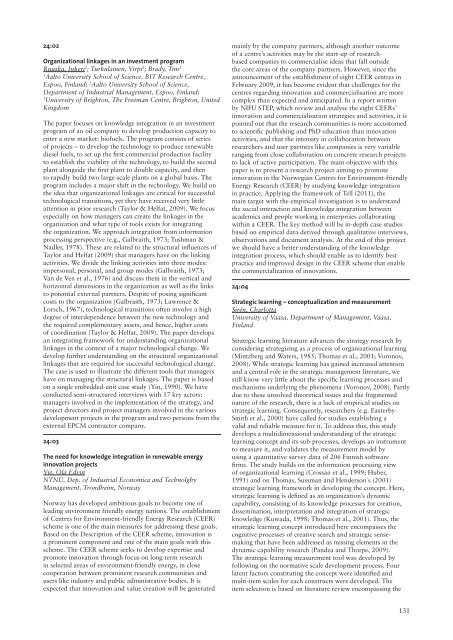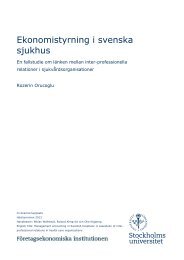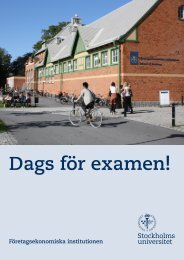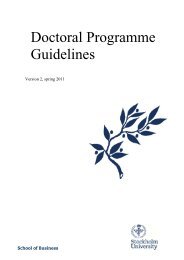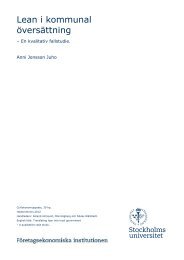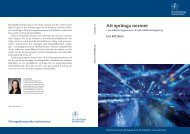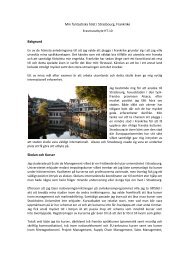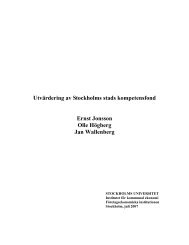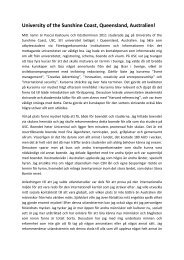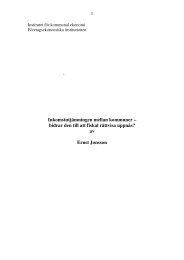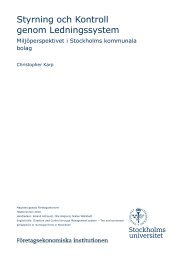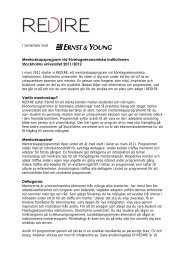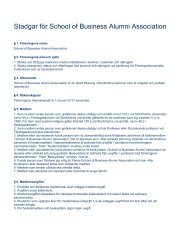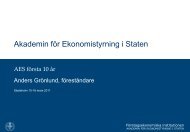Download full programme and abstract book pdf 1.6
Download full programme and abstract book pdf 1.6
Download full programme and abstract book pdf 1.6
Create successful ePaper yourself
Turn your PDF publications into a flip-book with our unique Google optimized e-Paper software.
24:02<br />
Organizational linkages in an investment program<br />
Ruuska, Inkeri1 ; Turkulainen, Virpi2 ; Brady, Tim3 1Aalto University School of Science, BIT Research Centre,<br />
Espoo, Finl<strong>and</strong>; 2Aalto University School of Science,<br />
Department of Industrial Management, Espoo, Finl<strong>and</strong>;<br />
3University of Brighton, The Freeman Centre, Brighton, United<br />
Kingdom<br />
The paper focuses on knowledge integration in an investment<br />
program of an oil company to develop production capacity to<br />
enter a new market: biofuels. The program consists of series<br />
of projects – to develop the technology to produce renewable<br />
diesel fuels, to set up the first commercial production facility<br />
to establish the viability of the technology, to build the second<br />
plant alongside the first plant to double capacity, <strong>and</strong> then<br />
to rapidly build two large-scale plants on a global basis. The<br />
program includes a major shift in the technology. We build on<br />
the idea that organizational linkages are critical for successful<br />
technological transitions, yet they have received very little<br />
attention in prior research (Taylor & Helfat, 2009). We focus<br />
especially on how managers can create the linkages in the<br />
organization <strong>and</strong> what type of tools exists for integrating<br />
the organization. We approach integration from information<br />
processing perspective (e.g., Galbraith, 1973; Tushman &<br />
Nadler, 1978). These are related to the structural influences of<br />
Taylor <strong>and</strong> Helfat (2009) that managers have on the linking<br />
activities. We divide the linking activities into three modes:<br />
impersonal, personal, <strong>and</strong> group modes (Galbraith, 1973;<br />
Van de Ven et al., 1976) <strong>and</strong> discuss them in the vertical <strong>and</strong><br />
horizontal dimensions in the organization as well as the links<br />
to potential external partners. Despite of posing significant<br />
costs to the organization (Galbraith, 1973; Lawrence &<br />
Lorsch, 1967), technological transitions often involve a high<br />
degree of interdependence between the new technology <strong>and</strong><br />
the required complementary assets, <strong>and</strong> hence, higher costs<br />
of coordination (Taylor & Helfat, 2009). The paper develops<br />
an integrating framework for underst<strong>and</strong>ing organizational<br />
linkages in the context of a major technological change. We<br />
develop further underst<strong>and</strong>ing on the structural organizational<br />
linkages that are required for successful technological change.<br />
The case is used to illustrate the different tools that managers<br />
have on managing the structural linkages. The paper is based<br />
on a single embedded-unit case study (Yin, 1990). We have<br />
conducted semi-structured interviews with 17 key actors:<br />
managers involved in the implementation of the strategy, <strong>and</strong><br />
project directors <strong>and</strong> project managers involved in the various<br />
development projects in the program <strong>and</strong> two persons from the<br />
external EPCM contractor company.<br />
24:03<br />
The need for knowledge integration in renewable energy<br />
innovation projects<br />
Vie, Ola Edvin<br />
NTNU, Dep. of Industrial Economica <strong>and</strong> Technolghy<br />
Management, Trondheim, Norway<br />
Norway has developed ambitious goals to become one of<br />
leading environment friendly energy nations. The establishment<br />
of Centres for Environment-friendly Energy Research (CEER)<br />
scheme is one of the main measures for addressing these goals.<br />
Based on the Description of the CEER scheme, innovation is<br />
a prominent component <strong>and</strong> one of the main goals with this<br />
scheme. The CEER scheme seeks to develop expertise <strong>and</strong><br />
promote innovation through focus on long-term research<br />
in selected areas of environment-friendly energy, in close<br />
cooperation between prominent research communities <strong>and</strong><br />
users like industry <strong>and</strong> public administrative bodies. It is<br />
expected that innovation <strong>and</strong> value creation will be generated<br />
mainly by the company partners, although another outcome<br />
of a centre’s activities may be the start-up of researchbased<br />
companies to commercialise ideas that fall outside<br />
the core areas of the company partners. However, since the<br />
announcement of the establishment of eight CEER centres in<br />
February 2009, it has become evident that challenges for the<br />
centres regarding innovation <strong>and</strong> commercialisation are more<br />
complex than expected <strong>and</strong> anticipated. In a report written<br />
by NIFU STEP, which review <strong>and</strong> analyse the eight CEERs’<br />
innovation <strong>and</strong> commercialisation strategies <strong>and</strong> activities, it is<br />
pointed out that the research communities is more accustomed<br />
to scientific publishing <strong>and</strong> PhD education than innovation<br />
activities, <strong>and</strong> that the intensity in collaboration between<br />
researchers <strong>and</strong> user partners like companies is very variable<br />
ranging from close collaboration on concrete research projects<br />
to lack of active participation. The main objective with this<br />
paper is to present a research project aiming to promote<br />
innovation in the Norwegian Centres for Environment-friendly<br />
Energy Research (CEER) by studying knowledge integration<br />
in practice. Applying the framework of Tell (2011), the<br />
main target with the empirical investigation is to underst<strong>and</strong><br />
the social interaction <strong>and</strong> knowledge integration between<br />
academics <strong>and</strong> people working in enterprises collaborating<br />
within a CEER. The key method will be in-depth case studies<br />
based on empirical data derived through qualitative interviews,<br />
observations <strong>and</strong> document analysis. At the end of this project<br />
we should have a better underst<strong>and</strong>ing of the knowledge<br />
integration process, which should enable us to identify best<br />
practice <strong>and</strong> improved design in the CEER scheme that enable<br />
the commercialization of innovations.<br />
24:04<br />
Strategic learning – conceptualization <strong>and</strong> measurement<br />
Sirén, Charlotta<br />
University of Vaasa, Department of Management, Vaasa,<br />
Finl<strong>and</strong><br />
Strategic learning literature advances the strategy research by<br />
considering strategizing as a process of organizational learning<br />
(Mintzberg <strong>and</strong> Waters, 1985; Thomas et al., 2001; Voronov,<br />
2008). While strategic learning has gained increased attention<br />
<strong>and</strong> a central role in the strategic management literature, we<br />
still know very little about the specific learning processes <strong>and</strong><br />
mechanisms underlying the phenomena (Voronov, 2008). Partly<br />
due to these unsolved theoretical issues <strong>and</strong> the fragmented<br />
nature of the research, there is a lack of empirical studies on<br />
strategic learning. Consequently, researchers (e.g. Easterby-<br />
Smith et al., 2000) have called for studies establishing a<br />
valid <strong>and</strong> reliable measure for it. To address this, this study<br />
develops a multidimensional underst<strong>and</strong>ing of the strategic<br />
learning concept <strong>and</strong> its sub-processes, develops an instrument<br />
to measure it, <strong>and</strong> validates the measurement model by<br />
using a quantitative survey data of 206 Finnish software<br />
firms. The study builds on the information processing view<br />
of organizational learning (Crossan et al., 1999; Huber,<br />
1991) <strong>and</strong> on Thomas, Sussman <strong>and</strong> Henderson´s (2001)<br />
strategic learning framework in developing the concept. Here,<br />
strategic learning is defined as an organization’s dynamic<br />
capability, consisting of its knowledge processes for creation,<br />
dissemination, interpretation <strong>and</strong> integration of strategic<br />
knowledge (Kuwada, 1998; Thomas et al., 2001). Thus, the<br />
strategic learning concept introduced here encompasses the<br />
cognitive processes of creative search <strong>and</strong> strategic sensemaking<br />
that have been addressed as missing elements in the<br />
dynamic capability research (P<strong>and</strong>za <strong>and</strong> Thorpe, 2009).<br />
The strategic learning measurement tool was developed by<br />
following on the normative scale development process. Four<br />
latent factors constituting the concept were identified <strong>and</strong><br />
multi-item scales for each constructs were developed. The<br />
item selection is based on literature review encompassing the<br />
131


